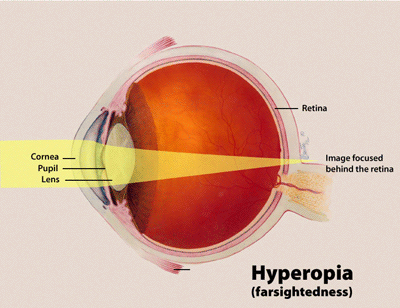| Glaucoma | Diabetic Eye Disease | Low Vision | Healthy Eyes |
Farsightedness
What is farsightedness?
Farsightedness, also known as hyperopia, is a common type of refractive error where distant objects may be seen more clearly than objects that are near. However, people experience farsightedness differently. Some people may not notice any problems with their vision, especially when they are young. For people with significant farsightedness, vision can be blurry for objects at any distance, near or far.

The cornea and lens bend (refract) incoming light rays so they focus behind the retina.
How does farsightedness develop?
Farsightedness develops in eyes that focus images behind the retina instead of on the retina, which can result in blurred vision. This occurs when the eyeball is too short, which prevents incoming light from focusing directly on the retina. It may also be caused by an abnormal shape of the cornea or lens.
Who is at risk for farsightedness?
Farsightedness can affect both children and adults. It affects about 5 to 10 percent of Americans. People whose parents are farsighted may also be more likely to get the condition.
What are the signs and symptoms of farsightedness?
The symptoms of farsightedness vary from person to person. Your eye care professional can help you understand how the condition affects you.
Common signs and symptoms of farsightedness include:
- Headaches
- Eyestrain
- Squinting
- Blurry vision, especially for close objects
How is farsightedness diagnosed?
An eye care professional can diagnose farsightedness and other refractive errors during a comprehensive dilated eye examination. People with this condition often visit their eye care professional with complaints of visual discomfort or blurred vision.
How is farsightedness corrected?
Farsightedness can be corrected with eyeglasses, contact lenses, or surgery.
Eyeglasses are the simplest and safest way to correct farsightedness. Your eye care professional can prescribe lenses that will help correct the problem and help you see your best.
Contact lenses work by becoming the first refractive surface for light rays entering the eye, causing a more precise refraction or focus. In many cases, contact lenses may provide clearer vision, wider field of vision, and greater comfort. They are a safe and effective option if fitted and used properly. However, contact lenses may not be the best option for everyone.
If you certain eye conditions you may not be able to wear contact lenses. Discuss this with your eye care professional.
Refractive surgery aims to permanently change the shape of the cornea which will improve refractive vision. Surgery can decrease or eliminate dependency on wearing eyeglasses and contact lenses. There are many types of refractive surgeries and surgical options should be discussed with an eye care professional.




